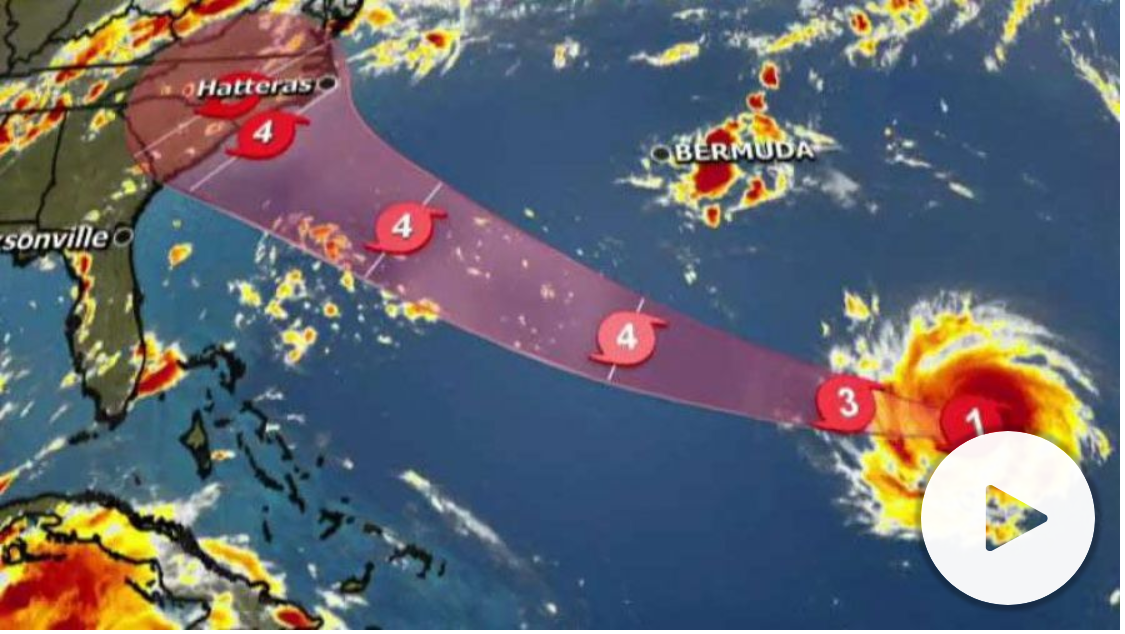Hurricane Florence is spinning up to be a Category 4 Hurricane. It’s predicted to make landfall between North Carolina and Georgia this week. Virginia may be impacted when Florence comes ashore at the end of this week.
Virginia announces a state of emergency ahead of Hurricane Florence.
Preparing For A Major Hurricane or Tropical Storm
When a hurricane is 36 hours from arriving
- Turn on your TV or radio in order to get the latest weather updates and emergency instructions.
- Restock your emergency preparedness kit. Include food and water sufficient for at least three days, medications, a flashlight, batteries, cash, and first aid supplies.
- Plan how to communicate with family members if you lose power. For example, you can call, text, email or use social media. Remember that during disasters, sending text messages is usually reliable and faster than making phone calls because phone lines are often overloaded.
- Review your evacuation zone, evacuation route and shelter locations. Plan with your family. You may have to leave quickly so plan ahead.
- Keep your car in good working condition, and keep the gas tank full; stock your vehicle with emergency supplies and a change of clothes.
When a hurricane is 18-36 hours from arriving
- Bookmark your city or county website for quick access to storm updates and emergency instructions.
- Bring loose, lightweight objects inside that could become projectiles in high winds (e.g., patio furniture, garbage cans); anchor objects that would be unsafe to bring inside (e.g., propane tanks); and trim or remove trees close enough to fall on the building.
- Cover all of your home’s windows. Permanent storm shutters offer the best protection for windows. A second option is to board up windows with 5/8” exterior grade or marine plywood, cut to fit and ready to install.
When a hurricane is 6-18 hours from arriving
- Turn on your TV/radio, or check your city/county website every 30 minutes in order to get the latest weather updates and emergency instructions.
- Charge your cell phone now so you will have a full battery in case you lose power.
When a hurricane is 6 hours from arriving
- If you’re not in an area that is recommended for evacuation, plan to stay at home or where you are and let friends and family know where you are.
- Close storm shutters, and stay away from windows. Flying glass from broken windows could injure you.
- Turn your refrigerator or freezer to the coldest setting and open only when necessary. If you lose power, food will last longer. Keep a thermometer in the refrigerator to be able to check the food temperature when the power is restored.
- Turn on your TV/radio, or check your city/county website every 30 minutes in order to get the latest weather updates and emergency instructions.
Survive DURING
- If told to evacuate, do so immediately. Do not drive around barricades.
- If sheltering during high winds, go to a FEMA safe room, ICC 500 storm shelter, or a small, interior, windowless room or hallway on the lowest floor that is not subject to flooding.
- If trapped in a building by flooding, go to the highest level of the building. Do not climb into a closed attic. You may become trapped by rising flood water.
- Listen for current emergency information and instructions.
- Use a generator or other gasoline-powered machinery outdoors ONLY and away from windows.
- Do not walk, swim, or drive through flood waters. Turn Around. Don’t Drown! Just six inches of fast-moving water can knock you down, and one foot of moving water can sweep your vehicle away.
- Stay off of bridges over fast-moving water.
Be Safe AFTER
- Listen to authorities for information and special instructions.
- Be careful during clean-up. Wear protective clothing and work with someone else.
- Do not touch electrical equipment if it is wet or if you are standing in water. If it is safe to do so, turn off electricity at the main breaker or fuse box to prevent electric shock.
- Avoid wading in flood water, which can contain dangerous debris. Underground or downed power lines can also electrically charge the water.
- Save phone calls for emergencies. Phone systems are often down or busy after a disaster. Use text messages or social media to communicate with family and friends.
- Document any property damage with photographs. Contact your insurance company for assistance.
Is Your IT Infrastructure Backed Up And Quickly Recoverable?
Many businesses aren’t prepared as they should be.
Yes, you’ve backed up your data to a storage device in the office, but won’t help if your building’s roof comes off. Your office will flood and your server, backup device, and computers will be left floating in Florence’s wake.
This may sound extreme, but it happens.
Unless your IT service company backs up your data to an enterprise-based cloud backup solution, you could lose all the information you’ve worked so hard to attain.
Better yet, ask your IT professional to virtualize your entire network. This means all of your data and software. If you lose your onsite data and applications, everything will be quickly recoverable within a few hours.
A cloud backup, on the other hand, can take days to recover, and you won’t have access to your software applications.
But you have to do this now. You only have a few days left.
Above all, be safe everyone.
Resources:
- https://www.ready.gov/hurricane-toolkit
- Hurricane Seasonal Preparedness Social Media Toolkit
- Hurricane Information Sheet (PDF)
- Six Things to Know Before a Disaster
- National Hurricane Center
- National Weather Service Hurricane Safety
- When the Waves Swell – Hurricane Animated (Video)
- How to Prepare for a Hurricane
- Hurricane Playbook
- Prepare Your Organization for a Hurricane Playbook
- Communication Tools
- Hurricane Creative Materials
- National Creative Resources
- https://www.ready.gov/hurricanes

